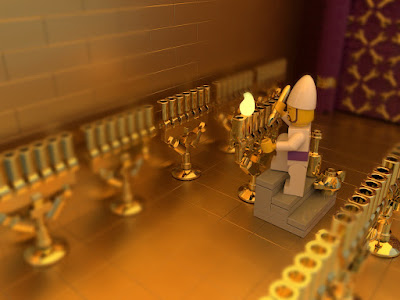The Shot
Night Light
A Kohen prepares the lamps of the Menorah for the evening lighting.
The Story
 |
| You are here |
The Menorah stood 18 tefachim [handbreadths] high, which is less than the height of an average adult. There were three stone steps in front of the Menorah for the Kohen to ascend so that he could better access the lamps to clean them and prepare them. Upon these steps was also where the Kohanim would place the various utensils needed to service the Menorah.
In the shot above, more than one Menorah is visible. When King Shlomo built the First Beis Hamikdash he fashioned ten copies of the Menorah and placed them on either side of the original, five to the north and five to the south. We are not told why he did so, and the lamps on these copies were not lit. The same practice was followed in the Second Beis Hamikdash, as pictured above. [Although the setup as well as the interior of the building was nearly identical in both Temples, true students of the Beis Hamikdash can tell that the picture above depicts the Second Beis Hamikdash. The clue is in the background: In the First Beis Hamikdash there was a solid wall dividing the Holy from the Holy of Holies, whereas in the Second these areas were divided by a curtain. The curtain, which ran the entire width of the room, was folded back at the southern end and pinned with a golden clasp or band so that the Kohen Gadol could enter there without having to move the curtain with his hands.]
The Setup
This shot is modeled and rendered in Bricklink Studio with depth of field added in Photoshop (read more about this process in my introduction). The interior of this entire building was plated in gold from floor to ceiling, and for this purpose I used a lot of bricks in Metallic Gold. The interior of the Holy had very little natural light and so to add to the ambiance and really pick up the highlights on the gold I included a number of large plates in Luminous Soft Amber overhead.
The curtain is made of purple plates with golden minifig hands in the tubes, arranged in a geometric pattern of this artist's own design. The open end of the curtain is made of 2x2 round bricks. Although only one curtain is shown here (since that is all you would see while inside the Holy) there was another curtain identical to this one just to the west (to the right, in this picture) of this one with a one-amah space between them. The Kohen Gadol would walk between these curtains (entering from the open end in the south as seen in this picture) to get into the Holy of Holies.
Credit for the elegant Menorah design goes to my colleague Yitzy Kasowitz of Jbrick. It is difficult to inject so much detail at minifig scale into something as intricate as the Menorah but he has done a masterful job. The seven lamps are bar holders with clips (11090) neatly lined up on a 1x4 tile. To suggest the branching arms of the Menorah he again uses bar holders, one on each side. The branches emerged straight out of the central stem, unlike the curved branches seen in many standard depictions of the Menorah, and this aligns with the opinion of Rambam.
Lego® is a trademark of the LEGO Group of companies which does not sponsor, authorize, or endorse this site.



No comments:
Post a Comment
To prevent spam, all comments will be moderated.